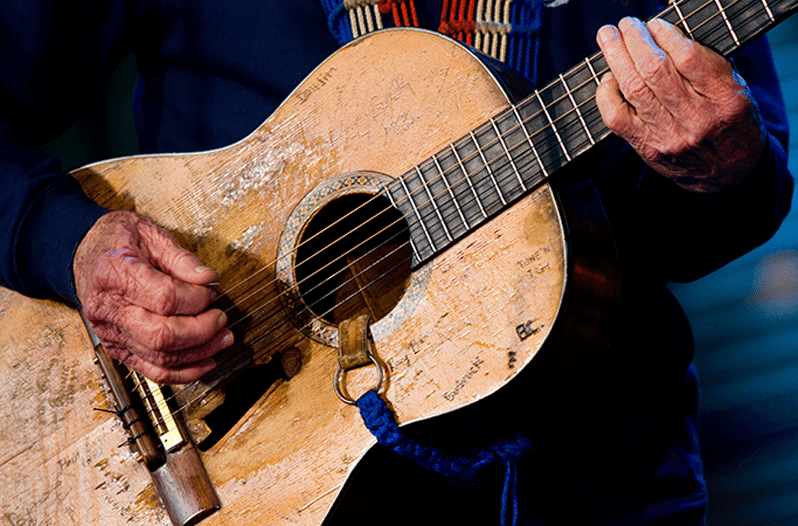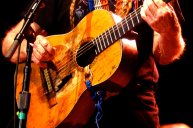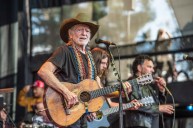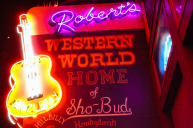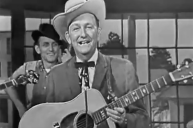Country music, more than most music styles, is about storytelling, and every great storyteller has a tool to help them tell their tales. Some country music instruments -- like steel guitars, acoustic guitars, and more -- even have stories of their own. Of course, that's primarily because of the talented country singers who played them in our favorite popular music, but these instruments have taken on their own legends.
Videos by Wide Open Country
From folk music to bluegrass music, here are 10 legendary country music instruments and who changed the classic country music genre forever.
Read More: 'Honky Tonk Heroes': Waylon Jennings' Billy Joe Shaver-Penned Outlaw Anthem
10. DeFord Bailey's Harmonica
DeFord Bailey holds the distinct honor of being the first male country artist introduced on the legendary radio program, the Grand Ole Opry. He also became the first African American inducted. Bailey began playing popular harmonica tunes at the Opry almost since its establishment. His virtuoso harmonica playing landed him as a featured performer on the biggest tours of the day, including Bill Monroe and Roy Acuff. The grandson of slaves, Bailey overcame childhood illness (polio) and poverty to become the most influential harmonica player in the 20th century and one of country music's true inspirations. Bailey attributed his passion to his parents, who gave him his legendary harmonica. "My folks didn't give me no rattler," he said. "They gave me a harp."
9. Flaco Jiménez' Hohner Corona II Accordion
At first blush, accordion doesn't seem to have a huge place in country music. But Flaco Jiménez changed all that when he brought his world-class conjunto talents to the Texas Tornados. In many ways, Jiménez helped make country music an international affair with his accordion playing. The Tornados quickly rose to prominence in the early 1990s, snagging a Grammy for their mix of traditional Mexican Conjunto music with Texas country. They were a cultural revolution within the genre and helped open it up to many new collaborations down the road. A four-time Grammy winner, Jiménez has used his classic Hohner Corona II accordion on countless recordings. He's also played with plenty of other legends, including Dwight Yoakam, Bob Dylan, and The Rolling Stones.
8. Clarence White's Martin D-28
This guitar is perhaps one of the most "legendary" instruments in that quite a few legends surround it. The pre-WWII era Martin D-28 owned by Clarence White, that eventually made its way to Tony Rice, has a serious place in music lore. The whole story is actually quite amazing, as far as instruments go. But let's put it this way: the modified Martin D-28 needed a lot of loving before it became what's known as the "holy grail" of bluegrass instruments now. By the time Tony Rice turned it into the bluegrass music masterpiece it is today, nearly every well-known luthier in the states had worked on it. Bear in mind; this is a guitar White once leaned up against a tree and shot with a pellet gun. Seriously, read the whole story.
7. Monte Mountjoy's Drumset
If you think today's country music is controversial, take another look at 1944. Nowadays, we ask whether the squeaky clean pop production, loud guitars, and drum tracks constitute country music. Back then, they didn't think regular drums represented country music. Not until Bob Wills' drummer Monte Mountjoy rolled out his drum set onto the Grand Ole Opry stage at the last minute. The Opry had tons of rules, including no drums. Drums ain't country, you see. Well, they certainly were to Bob Wills and his Texas Playboys. Ignoring the "no drums" policy, Wills allowed Mountjoy to wheel out his drum set at the last minute for what many argue is the first-ever use of drums at the Opry. And there was no looking back from there.
6. Pete Seeger's Banjo
Few musicians have popularized the banjo quite like Pete Seeger. At first, a humble folk musician whose commercial success in the 1940s and 1950s propelled banjo into the limelight, Seeger eventually became a social activist who used his banjo for the greater good. He had a huge hand in the Civil Rights Movement in the 1960s and continued to use the banjo as a symbol of community and fighting oppression. Undoubtedly appropriate, considering the original banjo was built by African American slaves in the Caribbean in the 17th century. He inscribed the now-famous saying on his banjo head, "This machine surrounds hate and forces it to surrender."
5. Bill Monroe's 1923 Lloyd Loar Gibson F-5 Mandolin
"The most famous mandolin ever played," Bill Monroe's 1923 Gibson F-5 Mandolin is valued at a whopping $1.125 million. That's because one of the most famous American musicians ever used it for decades; its scratched and tattered surface adding to the classic sound. The instrument endured a lot, including getting smashed with a fire poker and being rebuilt out of the more than 500 fragments. Monroe also gouged out the "Gibson" name plate with a pocket knife after one particularly bad day. Amazingly, the instrument's eventual owner Robert McLean donated the million-dollar instrument to the Country Music Hall of Fame.
4. James Burton's Pink Paisley Fender Telecaster
James Burton may be the single most influential musician when it comes to electric guitar in country music. Why is that? Because his classic use of the Fender Telecaster completely revolutionized the sound of country music and ushered in the electric era. Burton played with some of the great American artists beginning in the 1950s, including Elvis Presley, Johnny Cash, Merle Haggard, The Everly Brothers, and more. His classic telecaster skills inspired modern ax-slingers like Brad Paisley and Keith Urban, not to mention just about anybody looking to add some twang to their guitar. He's even got his own special model (the first) sold by Fender.
3. Johnny Gimble's Fiddle
If you don't know Johnny Gimble's name, you certainly know his classic fiddle licks. The famous fiddler toured as a Texas Playboy for a decade before later joining Willie Nelson. He also played and crafted classic licks for artists like Merle Haggard, Dolly Parton, George Strait, and many others. All the while, he played on his original violin, which he purchased in Germany during WWII. After accidentally backing over the fiddle with his car (seriously), Gimble found a luthier who helped piece it back together in 1970. A proud Texan, Gimble's stringed instrument now resides at the Bob Bullock Texas State History Museum in Austin.
2. Jimmie Rodgers' 1927 Martin 00-18
Here's what you need to know about Jimmie Rodgers' 1927 Martin 00-18 guitar: The skilled guitarist used it for the Bristol sessions. For those unaware, the Bristol sessions spawned Jimmie Rodgers and the Carter Family, not to mention the first verifiable commercially successful recordings of country music. Quite simply, this guitar was the instrument used to birth commercial American country music as we know it.
1. Willie Nelson's Martin N-20 "Trigger"
Trigger is as much a part of Nelson's career as his famous red braids or hit country songs. Officially a Martin N-20 nylon-string guitar, Trigger appears everywhere Nelson does. After a drunk broke his guitar at a show in Helotes, Texas (at Floore's Country Store), Nelson had a luthier move his old pickup into this new guitar in Nashville. The classic, unmistakable sound helped define Willie Nelson's brand of outlaw country. It's famously the only thing Nelson saved from his Tennessee house fire. Trigger -- named after Roy Rogers' horse -- also went away in hiding for a while so the IRS couldn't repossess it when Nelson found himself in major tax trouble. Signed by dozens of musicians Nelson asked personally and featuring a classic chunk missing; Trigger is as a beloved part of country-western music as Nelson himself.
